|
Interaction and interference
|
Transport through systems in which the dwelling time in the
junction is large enough or in other terms in which the coupling
to the leads is not so strong are strongly affected by
electron-electron interaction. In these conditions a mean field
approach to the problem is not justified. A very reach physics
belongs to this regime, from the Coulomb blockade to the Kondo
effect, experimentally accessible also at the nano scale. On the
other hand, interference characterizes fundamental discoveries in
mesoscopic physics, like the solid state realization of the
Ahronov-Bohm effect, or the weak localization. More recently
intramolecular interference have also attracted increasing
attention. In recent works on benzene and triple dot junctions I
have already proven that Coulomb blockade and interference can
coexist in what we named an interference single electron
transistor (ISET). Under the necessary condition
of the presence of quasi-degeneracies,
Coulomb interaction even favours interference in ISETs. |
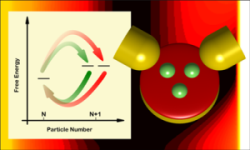 |
|
Orbital complexity
|
The transport
characteristics of nano-junctions depend on their energy spectrum
but also on the spatial distribution and spin arrangement of their
many-body energy eigenstates i.e. on their orbital
complexity. Particularly in the field of molecular electronics,
the tendency is to cope with this complexity either by treating
the system ab initio but at the price of relegating the
interaction to more or less sophisticated effective single
particle approaches, or to study the fully interacting dynamics,
also non-perturbative in the coupling to the leads, but assuming
over-simplified models that sometimes loose the specific character
of the junction. In the study of the benzene interference SET we
adopted an intermediate strategy: we described the system via a
semi-empirical interacting Hamiltonian, proceeded to its exact
diagonalization (Configuration Interaction method) and finally set
up the transport calculation in the eigenbasis of the isolated
molecule. Due to the relatively high complexity
the problem (4096 states) we used a group theoretical approach
that simplified the diagonalization procedure but above all
allowed to classify the eigenstates according to their symmetry.
Most of the transport features could indeed be related to the
symmetry of the many-body states. |
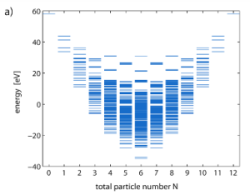 |
|
Current transfer
|
The tunnelling processes in a
nano-junction can be confined to a very narrow region, virtually a
point. Good examples are the tunnelling between an STM tip and the
substrate or an ideal break junction with a molecule or a atomic
chain stretched between the leads. In other cases the tunnelling
area is relatively extended compared to the system size. Examples
are the substrate-molecule interface in coated STM molecular
junctions or in carbon nanotubes transistors where typically a
considerable fraction of the tube is embedded into the lead. To my
knowledge little is known about the role played in the tunnelling
process, and consequently in the current voltage characteristics,
by momentum or angular momentum conservation. In contrast, the
accent has been always put only on energy conservation and the
consequent classification of transport as due to in elastic or
inelastic processes. |
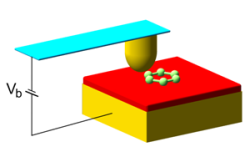 |
|
Nano-electromechanics
|
Progress in the fabrication of
nano-junctions has opened in recent years the access to the
mechanical degrees of freedom. Suspended carbon nanotubes,
molecular junctions, as well as free standing silicon based
devices are just some examples of systems in which the presence of
movable parts change qualitatively the transport characteristics
of the nano-junction. Since my Ph.D. thesis I am interested in
nanoelectromechanical systems (NEMS). I investigated the various
transport regimes in which a quantum shuttle (oscillating quantum
dot) can operate and looked for signatures into the current and
current noise. More recently I also studied the dynamical symmetry
breaking realized by in the non-linear transport through a molecular
junction with equivalent mechanical configurations. At present I am
working on the effect of phonons in the transport through suspended
carbon nanotubes. |
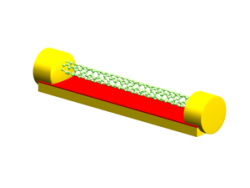 |
|
Spintronics
|
The spin degree of freedom plays an important
role in nano-junctions due to the ferromagnetic leads and/or to
the exchange interaction in the system itself. I studied spin
effects in molecular and double or triple quantum dot junctions. The interplay of leads polarization with interference effects allows to achieve in these systems all electrical spin control of the nanojunction. At present, I am focusing on transport through metal
phthalocyanines in the STM setup. |
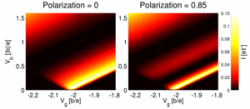 |





